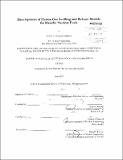Development of fission gas swelling and release models for metallic nuclear fuels
Author(s)
Andrews, Nathan Christopher
DownloadFull printable version (29.96Mb)
Other Contributors
Massachusetts Institute of Technology. Dept. of Nuclear Science and Engineering.
Advisor
Mujid S. Kazimi.
Terms of use
Metadata
Show full item recordAbstract
Fuel swelling and fission gas generation for fast reactor fuels are of high importance since they are among the main limiting factors in the development of metallic fast reactor fuel. Five new fission gas and swelling modules for the fast reactor metallic fuel code FEAST-METAL were developed. This increases the number of degrees of freedom in the code and enhances the science -based modeling options for fuel swelling. All of the modules developed were benchmarked against data from EBRII. Particularly, the code was benchmarked against U-19Pu-lOZr fuel and was applied to U-6Zr fuel. The modifications made still kept the overall GRSIS algorithm present in the code. The GRSIS model tracks "closed" and "open" bubbles. The new modifications increased the number of closed bubble groups used in the algorithm, inserted a model that changed the bubble groups from being based on constant volumes to ones with constant numbers of atoms, added phase dependence and reexamined closed bubble spacing through the implementation of a Monte-Carlo algorithm to calculate the effective distance between the nearest bubbles. All model options added to the code predicted the swelling, fission gas release and cladding strain effectively for the benchmark cases. However, significant differences in the results were fotind when the codes were applied to long-term U-6Zr fuel. The differences in the results cannot be resolved without more data on fuel behavior under irradiation; particularly, breeder fuel (blanket) data is needed to develop effective benchmarks. Until more data becomes available, it is advisable to use the original two group constant volume version of the code and the phase dependent version of the code and compare the results. The latter offers a much more scientifically based version of the code. Sensitivity analysis to the number of bubble groups indicate limited benefit may be obtained by using more than 2 bubble sizes. Additionally, care should be taken to ensure that the axial nodding of the fuel be such that the axial mesh length is smaller than 10% of the fuel length. Furthermore, if the FEAST code is to be used in a coupled fashion with the coolant sub-channel analysis code COBRA, the accuracy of the results depend on the model used for fuel swelling.
Description
Thesis (S.M.)--Massachusetts Institute of Technology, Dept. of Nuclear Science and Engineering, 2012. Cataloged from PDF version of thesis. Includes bibliographical references (p. 145-146).
Date issued
2012Department
Massachusetts Institute of Technology. Department of Nuclear Science and EngineeringPublisher
Massachusetts Institute of Technology
Keywords
Nuclear Science and Engineering.